If you have osteoarthritis of the knee, you may wonder which activities are safe, which will cause you pain and which will bring relief. This guide from the Texas Knee Institute highlights the dos and don’ts of arthritis knee pain relief.

Exercise for Arthritis Knee Pain Relief
While some forms of exercise can help ease knee osteoarthritis pain. Unfortunately, exercise could also cause pain or even worsen your condition if you don’t take the proper precautions. Before beginning any exercise program, be aware of your current state of joint health and pain levels, so you can track any discomfort that may be associated with new movements. Also, be sure to clear new workout routine with your healthcare provider. Then, when you’re ready to get moving:
Do
- Move joints gently. Daily stretching and low-impact workouts such as progressive strength training, biking, walking or swimming are all ideal for lubricating joints and preserving mobility. They can also help build muscles to support your movement, taking pressure off your joints.
- Focus on form. Meeting with a physical therapist can help you move in ways that protect your joint health.
- Listen to your body. Make sure to rest if you feel fatigued or experience any discomfort.
Don’t
Engage in high impact activities, or workouts that involve lots of jumping. Steer clear of repetitive motions as well, since they can place too much pressure on your knee joints.
Lifestyle Measures
Changes in the way you live may help manage arthritis pain and prevent disease progression.
Do
- Manage your weight, since carrying extra weight puts excess pressure on your knee joints, contributing to or even worsening osteoarthritis symptoms.
- Consider massage, as it can temporarily relieve pain and stiffness. Just be sure your massage therapist is aware of your condition, and clear your treatments with your healthcare provider.
Don’t
Light up. When you smoke, you cause stress to your connective tissues. This can worsen osteoarthritis symptoms, so now’s the time to quit if you haven’t already.
Medications for Knee Pain Relief
Early-stage osteoarthritis of the knee may be manageable with medication.
Do
Look for over-the-counter options such as Tylenol, Aleve or Advil for occasional pain relief, making sure you’ve cleared your choice with a healthcare provider to be sure it’s safe for you and doesn’t interact with any other medications you may be taking. You may also look for topical joint pain relievers that contain capsaicin.
.Don’t
Avoid overuse of pain medication, since even over the counter pain relievers can cause dangerous side effects when taken in high doses for extended periods of time. If you are not able to find knee pain relief with the occasional support of medication, it may be time to start exploring a knee procedure that will provide longer lasting relief.
Lasting Relief in Houston and Dallas
When you’re ready for an arthritis treatment that goes beyond lifestyle changes or medication, Genicular Artery Embolization (GAE) can offer knee pain relief without surgery. For many patients, this option can also help preserve mobility and prevent disease progression, while allowing you to delay or avoid a total knee replacement. Explore your candidacy for GAE by requesting a consultation requesting a consultation requesting a consultation at the Texas Knee Institute.
Many people wonder, ‘How long does genicular artery embolization last?’ Well now, a study on the effects of genicular artery embolization can help answer that question. And the results look promising for those who wish to delay or avoid total knee replacement surgery. Here’s what you need to know.

Effects of Genicular Artery Embolization
Here at the Texas Knee Institute, our interventional radiologists perform genicular artery embolization (GAE), a minimally invasive procedure designed to provide knee pain relief while avoiding invasive surgery. As a relatively new option for treating knee osteoarthritis, there is relatively little data available on how long the effects of genicular artery embolization will last. And that’s why we were excited to see a new study in the Journal of Vascular and Interventional Radiology discussing the lasting effects of GAE for pain relief.
For the study, researchers spent two years following 40 patients with moderate to severe knee pain caused by osteoarthritis. None of the patients were candidates for knee replacement surgery, so they all underwent GAE. Over the course of the study, candidates measured their pain scores. And, throughout the entire course of the study, the post-GAE patients experienced ongoing relief from osteoarthritis knee pain.
As a result, the study authors concluded, "Knee osteoarthritis is a leading cause of adult disability and, until now, most minimally invasive treatment options have been proven to provide only short-term relief, measured in weeks or months. For patients who are not candidates for knee replacement surgery, our study shows that GAE provides durable benefit to many patients, measurable for up to 2 years, a great leap forward in offering this cohort lasting relief."
Exploring GAE in Houston and Dallas
As we learn more about how and why osteoarthritis causes knee pain, it’s become clear that new, abnormal synovial blood vessels grow with this condition, causing painful inflammation and worsening other arthritis symptoms. By blocking blood flow to these vessels, GAE can reduce pain and inflammation, simultaneously improving quality of life for knee pain sufferers.
Ready to see if you could benefit from the effects of genicular artery embolization? Request a consultation Request a consultation Request a consultation with our interventional radiologists. Together, we can explore your candidacy for GAE and get you on the optimal pathway to lasting knee pain relief.
When dealing with knee pain caused by osteoarthritis, there are a range of treatment options, including lifestyle interventions, medications, medical procedures and surgical intervention. When symptoms are severe, choosing a total knee replacement may seem like your best treatment option. However, before you make a final decision, you should be aware of the potential disadvantages of knee replacement surgery, highlighted in this post.
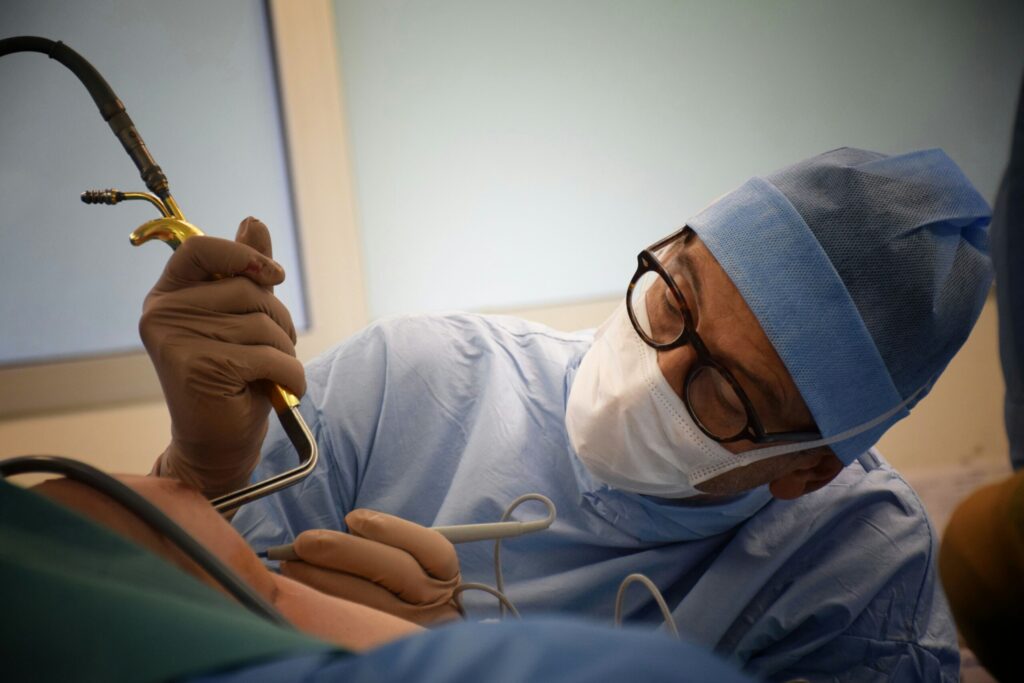
Potential Complications
Because it is an invasive procedure, knee replacement surgery has a higher risk for complication than other knee osteoarthritis treatment options. Though uncommon, this procedure could result in blood clots, nerve damage or infection. Additionally, the post-surgical recovery period can be long and quite uncomfortable. Finally, knee pain relief may not be complete, even after surgery, and future revision surgeries may be necessary. However, being aware of these disadvantages of knee replacement surgery—and carefully following post-procedural care instructions—can improve your outcomes and optimize your recovery. Alternatively, awareness can help you explore other, less invasive, treatment options.
5 Disadvantages of Knee Replacement Surgery
- Difficult Recoveries
The post-replacement recovery process is not easy: you’ll have to go to physical therapy, often for months, in order to regain your mobility and strength. You may have knee swelling, pain and stiffness after surgery. And you will need a support system to compensate for your initial loss of mobility.
- Need for Revisions
One of the disadvantages of knee replacement surgery is that I’s not a permanent solution—the replacement lasts between 15 and 20 years. Given that fact, if arthritis develops in the knee at an early age, it may make sense to delay surgery for as long as possible to reduce the likelihood that you’ll need multiple procedures.
- Consider the Cost
Depending on your insurance coverage, you may incur significant out of pocket expenses, since anesthesia and overnight hospital stays will be involved. Be sure to talk to your insurance company and healthcare provider prior to scheduling surgery in order to be accurately prepared.
- Mobility Limitations
While surgery should relieve knee pain, it may not restore your full range of motion, meaning you could still experience mobility challenges. As such, if your primary concern is maintaining or returning to an active lifestyle, you may wish to explore alternative treatment options.
- Infection Risks
Another possible disadvantage of knee replacement surgery is the potential for post-procedural infection. Following surgery, you’ll have to watch out for infection warning signs such as pain, redness, swelling or discharge at the site of your incision. If you notice any of these symptoms, you’ll need to call your doctor right away to prevent further complications.
Seeking Alternative Treatment Options
If you are concerned about the disadvantages of knee replacement surgery but still need relief from knee osteoarthritis pain, there are alternative options.
Here at the Texas Knee Institute, we perform Genicular Artery Embolization, or GAE, a minimally invasive procedure that reduces arthritis inflammation by targeting blood vessels that surround the knee joint. Studies suggest that GAE offers significant pain relief, helping people delay or avoid knee replacement surgery. Request a consultation Request a consultation Request a consultation with our experts to learn more about GAE and to see if you’re a candidate for this procedure.
Is it safe to run with knee arthritis? Well, running with arthritic knees is still possible. But you have to take careful precautions. And you should follow these tips to stay active without causing joint damage.
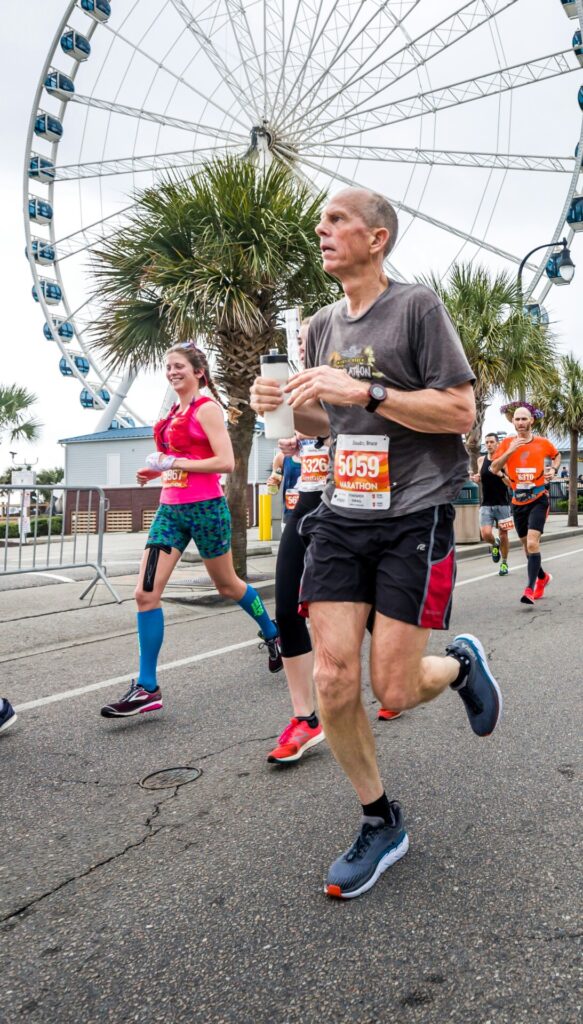
Running with Arthritic Knees: Start Slow
When you have knee osteoarthritis, joint pain could be a common concern. However, when you start running, you’ll have to listen to your body and decide if the discomfort you may feel is mild and associated with exercise, or if it’s sharp, suggesting you’ve suffered an injury or are causing joint damage.
Also, in order to prevent damage, you should slowly ease your way into a new running workout. Begin by moving at a mild pace, and don’t try to go too far. Then, as you get used to running with arthritis, you should be able to run farther and faster. And, in the process, you may even experience some knee pain relief. (More on that below.)
Choose Your Shoes Wisely
Running with arthritis demands appropriate, supportive foot wear. Choose pairs with plenty of cushioning to reduce the impact on your knees. Get a professional, in-store fitting. And make sure to mention your knee osteoarthritis when asking for help selecting your running shoes.
Consider Cross-Training, Too
If you’re running with arthritic knees, that should not be your only form of exercise: cross training will also be important for your health. Be sure to incorporate weight bearing exercises to take pressure off your knee joints by strengthening the muscles that support them. And try to engage in other, low-impact, forms of exercise like cycling or swimming, to help your joints and muscles recover in between higher-intensity training sessions.
Cycling is also an excellent exercise choice because the pedaling motion can lubricate the joints, helping reduce pain and improve your range of motion. But swimming is also a great option, since working out in the water will take pressure off your joints entirely.
Knee Pain Relief in Dallas and Houston
Is running with arthritic knees becoming too difficult due to joint pain? Do you want to find relief without surgery? At the Texas Knee Institute, we offer genicular artery embolization (GAE), a minimally invasive procedure designed to relieve arthritis pain while delaying or avoiding knee replacement surgery.
But what is GAE, exactly? This procedure reduces knee pain caused by osteoarthritis because it targets inflammation in your synovium (joint lining). It is a procedure that doesn’t require general anesthesia or an overnight hospital stay, and comes with an easier recovery period when compared to surgery. Want to see if you’re a GAE candidate? Request a consultation [/ga-appt-link] with our specialists in Texas, and we’ll review your treatment options when you come into the office.
At the Texas Knee Institute, our interventional radiologists in Houston and Dallas ease arthritis pain in the knee by performing Genicular Artery Embolization (GAE.) This is a minimally invasive procedure that reduces both pain and inflammation by limiting the flow of blood to your knee’s synovial lining. But how effective is this non-surgical procedure at relieving your knee pain due to osteoarthritis? Well, the numbers are in, and they’re pretty promising!
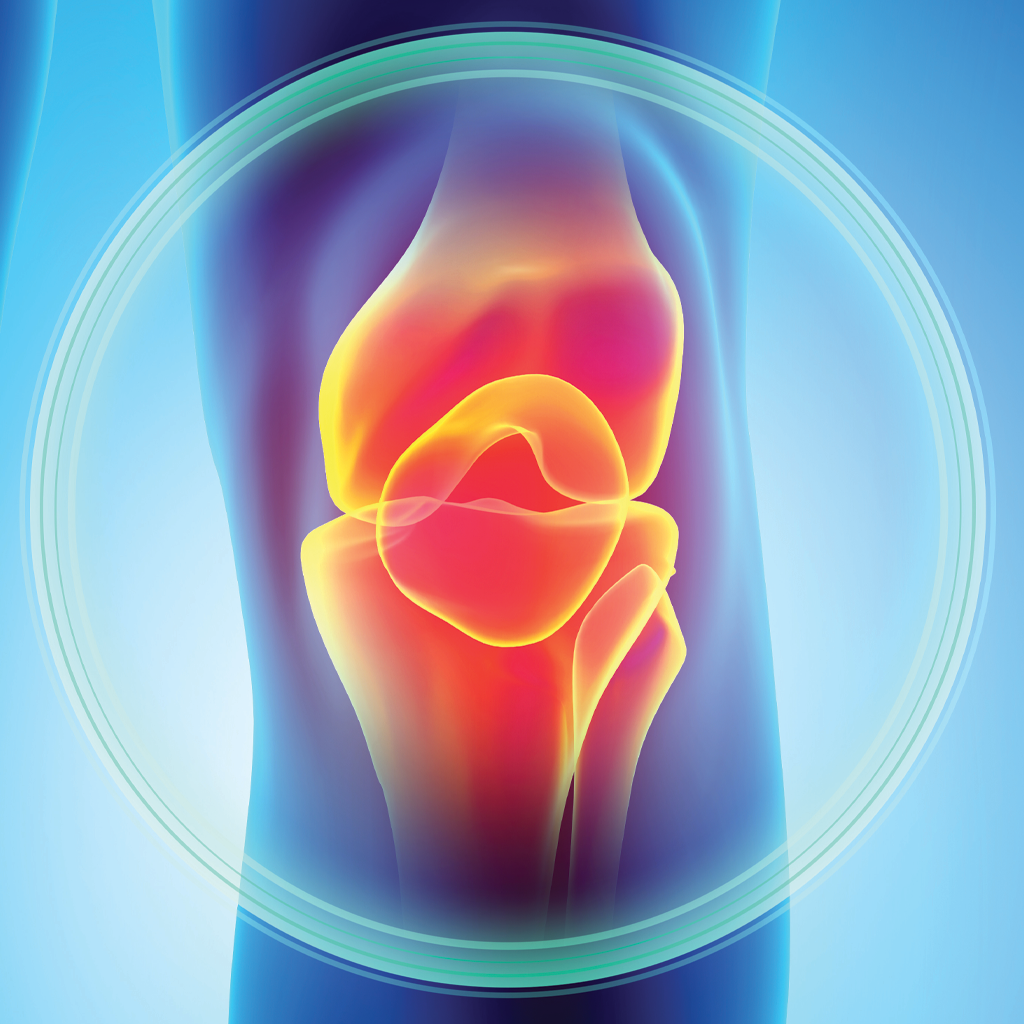
Does GAE Ease Arthritis Pain in the Knee? Check out These Stats!
Interventional radiology is a relatively new field of medicine. As such, long term data on the efficacy of GAE for reducing the pain of knee osteoarthritis is somewhat limited. But the evidence we do have is very promising.
At the Society of Interventional Radiology’s 2021 Annual Scientific Meeting, researchers presented findings on how well GAE was able to ease arthritis pain one year after patients underwent the procedure. The study followed 40 adults between the ages of 40 and 80 who needed knee pain relief due to mild to moderate osteoarthritis. Here’s what they found.
To begin with, one year after having GAE, patients enjoyed a 63% decrease in their personal pain scores. Moreover, their WOMAC osteoarthritis index scores had decreased by 60% at the one-year, post-procedural mark. (The WOMAC, or Western Ontario and McMaster Universities Arthritis Index, evaluates progression of hip and knee osteoarthritis by assessing stiffness, pain and ability to function physically on a daily basis. A lower score reflects improved mobility due to reduced pain and stiffness.)
Even better? None of the patients included in the study experienced major side effects. And the few who did, the adverse events were minor and mostly self-resolving. Plus, in light of the fact that the procedure was a technical success for 100% of the participants, lead study author Siddharth A. Padia, MD, FSIR says that, with GAE, interventional radiologists now have “the potential to completely disrupt and change the way patients are treated with knee osteoarthritis.”
How to Find Osteoarthritis Knee Pain Relief in Houston and Dallas
Want to ease arthritis pain without subjecting yourself to an invasive procedure like knee replacement surgery? Genicular Artery Embolization at the Texas Knee Institute could be the procedure you’ve been waiting for. And, to find out if that’s the case, simply click here to request a consultation click here to request a consultation click here to request a consultation with our experts.
If you’re suffering from osteoarthritis knee pain, you may be exploring treatment options, and choosing between genicular artery embolization vs knee surgery. But what’s involved in each of these procedures? And how can you choose the best option for your needs? Here’s what you need to know.

Knee Replacement for Osteoarthritis Pain
When you choose knee replacement surgery, your doctor will remove damaged bone and cartilage from your kneecap and some surrounding structures, replacing it with an implanted artificial joint. Constructed from plastic or metal, the replacement joint is designed to replicate the movements of your natural knee joint.
Due to the invasive nature of the procedure, you’ll need to go under general or regional anesthesia during the surgery, which typically lasts between one to two hours. Afterward, the incision site will be closed with staples or sutures, and your wound will be dressed carefully. During your recovery period, you’ll have to follow wound care instructions as well as all other post-operative directions from your doctor.
Genicular Artery Embolization
How does genicular artery embolization vs knee surgery compare in terms of what to expect during your procedure? Unlike surgery, genicular artery embolization (GAE) is a minimally invasive procedure designed to reduce knee osteoarthritis pain by decreasing the volume of blood flow that reaches the lining of your knee. Also lasting between one and two hours, GAE is an outpatient procedure performed with mild sedation rather than general anesthesia. During the procedure, our interventional radiologists insert a small catheter into your artery, guiding it to areas of inflammation with the help of X-ray imaging. Once in position, we inject tiny particles through that catheter; these block blood flow and reduce inflammation, providing osteoarthritis knee pain relief in the weeks and months following your procedure.
Genicular Artery Embolization Vs. Knee Replacement: What to Expect from the Recovery
If you undergo a knee replacement, you’ll likely need to stay in the hospital for up to three days afterward. And, your full recovery could last between 6 months and a year, though you’ll be able to return to your normal activities about six weeks after surgery. The initial healing period is likely to be painful, and many patients require physical therapy following their surgery.
In contrast, a genicular artery embolization recovery is far shorter. Most patients go home on the same day as their procedure, resuming light activities as early as one week afterward. Some discomfort is normal in the first few days following GAE, however you could start to experience knee pain relief as soon as two weeks after the procedure, with results continuing to improve from there.
Choosing the Best Treatment for Osteoarthritis Knee Pain
If you’re considering genicular artery embolization vs knee surgery to relieve your arthritis pain, here are some things to consider. If you choose knee replacement surgery, you should experience lasting relief. But you will also need to stay in the hospital and go through a more intense period of rehabilitation—along with a higher potential for complications. Plus, you must be physically healthy enough to undergo an invasive surgical procedure.
However, if you choose GAE at the Texas Knee Institute, you can enjoy months or years of knee pain relief and improved mobility without undergoing surgery or dealing with hospital stays. The risk for complications is minimal, and you can undergo GAE several times in order to delay or avoid knee replacement surgery. Ready to see if you’re a candidate for GAE in Texas? Click here to request a consultation Click here to request a consultation Click here to request a consultation
If you are living with knee osteoarthritis, it’s important to understand that this disease is progressive. And, as the disease advances, symptoms will worsen and mobility in your joints may be compromised. But what are the stages of knee osteoarthritis? And how can you find relief from painful symptoms? Here’s what you need to know!
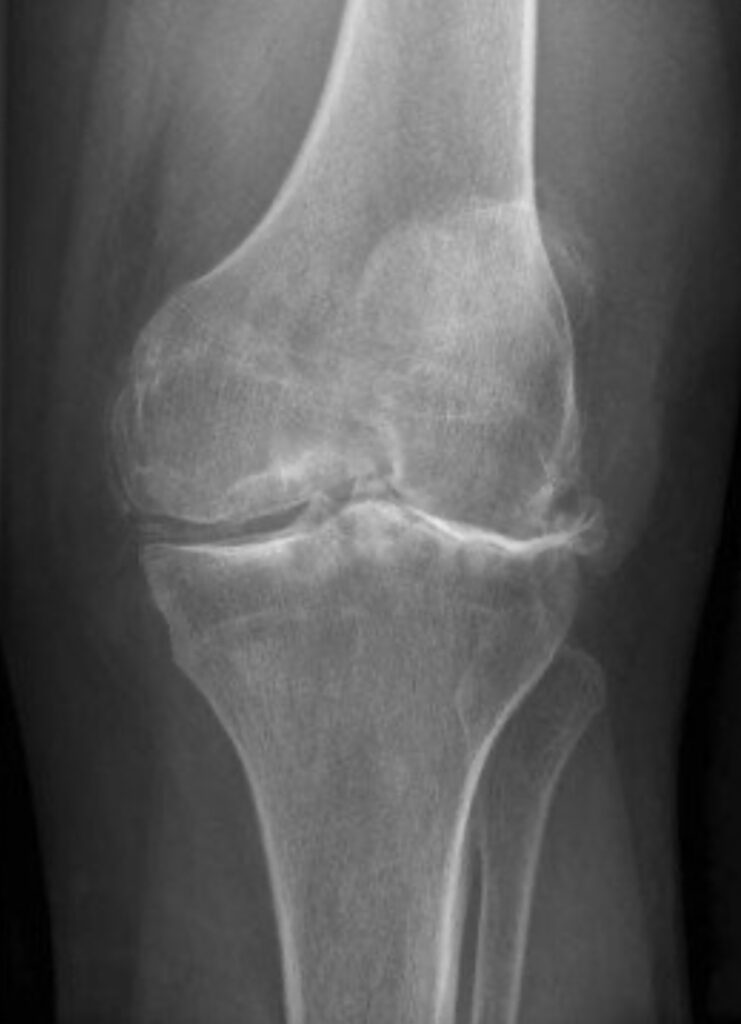
What is Knee Osteoarthritis?
Knee osteoarthritis is a disease that can affect your joint function and mobility. As we mentioned above, the disease is progressive and has no cure. However, there are stages of disease. And if you intervene before mobility is compromised, you may be able to stay active and delay or prevent further progression.
Stage 0: A Healthy Knee
If you show no symptoms of knee osteoarthritis, and there is no evidence of joint damage, your disease is classified as Stage 0. At this point, no treatment or intervention is recommended.
Minor Knee Osteoarthritis Pain: Stage 1
At this stage, your knee joints may show minor signs of wear and tear. You may also have slight growths of bone spurs on your joints, but you’re unlikely to experience pain. Still, if you have risk factors for arthritis, engaging in exercises for knee health could help prevent progression into stage two.
Stage 2
Here, we will notice more signs of bone spur growth when we x-ray your knee joints. Typically, the spaces between your joints will still appear normal, however, patients with stage 2 knee osteoarthritis are likely to experience symptoms such as joint pain and stiffness, especially after exercising, sitting for extended periods, or when you first wake up in the morning. Stage 2 patients may also start to experience cartilage break down. For some patients, progression and pain may be managed with lifestyle measures, including wearing braces or supports and focusing on strength training and exercise. However, some people will need additional interventions to find relief.
Moderate Knee Osteoarthritis: Stage 3
At this point, we will detect obvious cartilage erosion between your bones; the gap between bones will also have narrowed. At this point, inflammation in your joints will leave you experiencing frequent pain and stiffness. You may also notice that your knee makes a popping noise when you walk. Some stage 3 patients can manage their pain with medications. But, again, additional interventions may be necessary.
Stage 4
This is a severe stage of knee osteoarthritis—at this point of disease progression, your joint will be stiff because the cartilage has worn down significantly, leaving very little space between bones. Your synovial fluid that lines your knee joint will also decrease, so that you experience pain and friction when you try to move your joint. At stage 4, doing something as simple as trying to walk down the stairs could cause excruciating pain. As such, patients who reach this stage of disease progression are often forced to seek surgical treatments in order to relieve their discomfort. However, if you choose to seek help for knee osteoarthritis when you are still in stage two or three, the experts at the Texas Knee Institute can help relieve your pain with a non-surgical medical procedure.
Genicular Artery Embolization for Stage 2 and 3 Knee Osteoarthritis Relief
Genicular artery embolization (GAE) is a non-surgical procedure that can slow knee osteoarthritis progression. Recommended for stage 2 and 3 osteoarthritis patients who have not found relief from other, non-surgical interventions, it diminishes blood flow to the lining of your knee, reducing pain, inflammation and other symptoms. After undergoing GAE, you should be able to walk within two to three hours. Most patients will return to normal activities the day after the procedure, with symptom reduction becoming apparent within weeks of the procedure.
Ready to find relief for your arthritis symptoms, without the need for surgery? We’re here to help. Click here to request an appointment Click here to request an appointment Click here to request an appointment at the Texas Knee Institute.
Walking backward is a hot new fitness trend. Experts say that it helps reduce your risk for running injuries while mixing up your training routine. But can it help prevent or relieve the knee pain of osteoarthritis? here's what you need to know!

Walking Backward and Osteoarthritis Pain
When you're living with osteoarthritis knee pain, you may experience symptoms such pain, stiffness, swelling and limits on your range of motion. Now, many people will seek a medical procedure to relieve the discomfort of these symptoms. And, certainly, an intervention like Genicular Artery Embolization can relieve arthritis pain without the need for invasive knee replacement.
However, for those who are looking to manage their condition with lifestyle measures, walking backward may offer some important benefits, according to the experts. Why is that the case? When you walk backward, you use different muscles than when you propel yourself forward. Immediately, that can relieve some of the pressure on your sore, swollen joints.
Moreover, when you walk backward, you give more engagement to the quad muscles. This can stretch out the knee muscles, once again alleviating pain and also improving mobility. Finally, backward walking involves more thinking than moving forward, and this can help with balance and brain engagement as you age. Of course, this form of exercise can also come with a higher risk of tripping and falling. So you should practice the movement indoors, at a slow pace, and supervised by a friend or loved one to reduce your hazard risk.
When Walking Backward Doesn't Provide Enough Relief
If you're suffering from mild to moderate knee arthritis, lifestyle measures may provide sufficient pain relief. But if your condition is more severe, and you want relief without surgery, we encourage you to explore genicular artery embolization in Texas. Click here to request an appointmentClick here to request an appointmentClick here to request an appointment!
What's the best way to treat arthritis in knee? While there are many ways to relieve knee pain due to arthritis, one option is emerging as optimal because it is a lasting, non-surgical treatment for osteoarthritis of the knee. Called genicular artery embolization, or GAE, it's a minimally invasive procedure that reduces arthritis-related knee pain by reducing blood flow to the inflamed lining of the knee. But how does it work, who's a candidate, and why is it a great alternative to knee surgery? Here's what you need to know!

Best Way to Treat Arthritis in Knee: What are the Options?
Remember, knee osteoarthritis is a progressive, degenerative condition. As such, you need to seek some kind of treatment, or you'll experience disease progression and worsening Knee Osteoarthritis symptoms. Now, some patients can treat arthritis in the knee simply by maintaining an optimal weight, engaging in regular exercise and following a heart-healthy diet. However, many patients will still experience pain, stiffness and other disruptive symptoms unless they seek medical intervention.
Until recently, the main treatment option involved surgical knee replacement. But many people want knee pain relief without surgery, while others can not tolerate surgical interventions. In the past, that meant they were forced to suffer from arthritis pain without relief. Today, though, they can choose to undergo GAE, an alternative knee replacement that is the best way to treat arthritis in the knee without surgery.
What is GAE?
GAE is a surgical alternative for relieving symptomatic osteoarthritis of the knee. During this GAE procedure, our interventional radiologists insert a small catheter into your femoral artery, usually via a small puncture made in the area of your groin. We'll then guide the catheter to your genicular arteries, assisted by advanced X-ray imaging. Once the catheter reaches its target, we'll deposit tiny coils into the arteries, thereby decreasing and reducing osteoarthritis knee pain and inflammation.
Now, not everyone is a candidate for genicular artery embolization. But many have found that this is the best way to treat arthritis in knee without surgery. Ready to see if this is your best pathway to relief? Click here to request an appointmentClick here to request an appointmentClick here to request an appointment!
If you've been suffering with osteoarthritis of the knee, but want less invasive pain relief, you may be searching for knee replacement alternatives. Thankfully, due to advancements in the medical field, there are many ways to relieve your pain without surgery. Here are the procedures your need to know about.
Knee replacement alternatives: genicular artery embolization (GAE)
GAE is one of newest treatment options if you're seeking non-surgical knee replacement alternatives. Performed by our Interventional Radiologists at the Texas Knee Institute, this procedure works by restricting blood flow to the inflamed lining of your affected knee(s). Afterward, inflammation reduces, reducing or eliminating your knee pain. In fact, this 2020 study revealed that the procedure effectively reduces moderate to severe knee pain caused by osteoarthritis. Plus, by choosing to undergo GAE, you may prevent arthritis progression and help preserve your mobility.
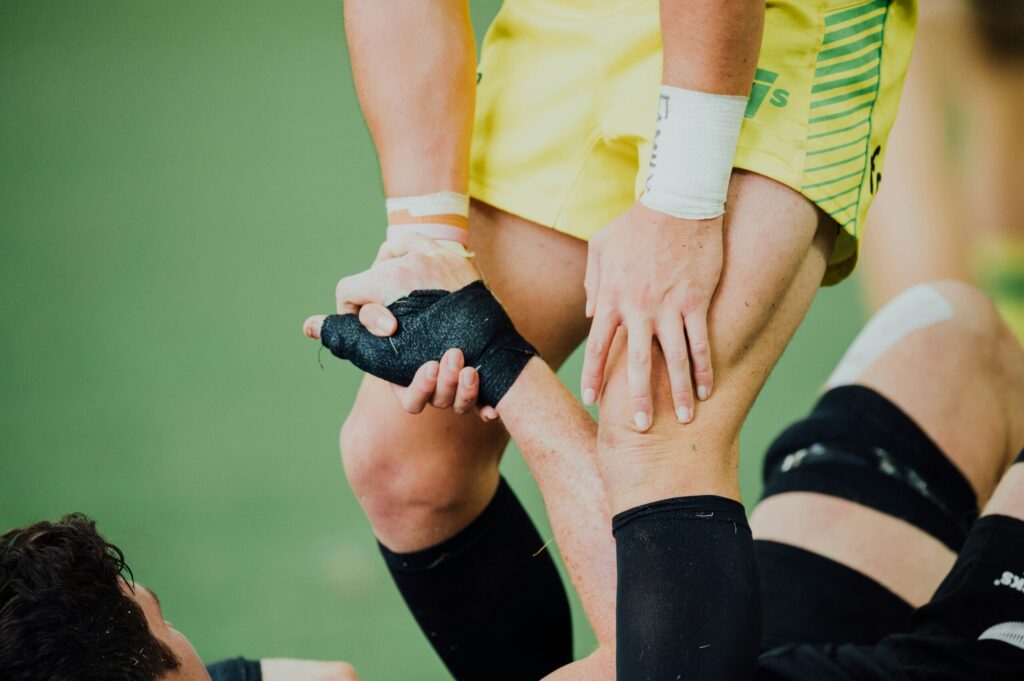
Injections to Relieve Osteoarthritis Knee Pain
Other knee replacement alternatives involve injections to your affected joint area. Some physicians recommend injecting hyaluronic acid to your inflamed knee joint, in order to reduce pain by lubricating the area and offering additional shock absorption. However, due to limited research on its effectiveness, the Arthritis Foundation does not currently endorse this treatment option.
Another option making headlines is dextrose solution injections for osteoarthritis knee pain. Touted as a form of regenerative medicine due to its potential to reduce pain and stiffness by directing healing blood flow to your knee, this option also lacks research on its effectiveness. As such, it is also not endorsed by the Arthritis Foundation.
Finally, for patients with mild to moderate arthritis knee pain, Platelet Rich Plasma (PRP) injections may provide Knee Pain Relief and improve mobility for up to one year. The treatment works by injecting the platelet-rich portion of your own blood into your affected knee, helping promote healing and healthy new cell growth. While patient reported results are positive, we still lack scientific research into the safety and efficacy of this knee replacement alternative.
Scientifically Backed Knee Replacement Alternatives
Want to relieve arthritis knee pain without surgery? But looking for knee replacement alternatives who's efficacy can be proven by science? Click here to request an appointmentClick here to request an appointmentClick here to request an appointment at the Texas Knee Institute to see if you're a candidate for GAE!







